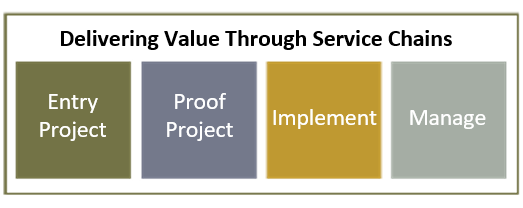This blog is part of a series on Service Chains. To read the first blog in the series, click here .
The Manage Phase is the last phase of a Service Chain in which the client agrees to and pays for an on-going pre-determined role for you that is integral to full realization and/or maintaining the value and benefits of the Idea and solution.
The Manage Phase maintains a meaningful and valuable presence with the client to sustain relevancy between further buying cycles, to create new buying cycles, etc. In other words, this phase is leveraged in the overall account journey and becomes integral in account management – done correctly the buyer pays the seller to remain engaged and creates the avenue to introduce or identify new opportunities and Ideas.
The Manage Phase encompasses continued or expanded realization of benefits, evolution of the organization’s application of the Idea to be more efficient or effective, and identification of new opportunities. It can involve a wide range of different activities. Examples include:
- Post-install tuning and optimization
- Training and support
- Maintenance Services
- Managed Services
- Business process outsourcing
- Technology hosting
- Periodic re-evaluation of performance
- Advice or assistance in managing or maintaining a new process, tool, etc.
These types of interaction can provide many benefits, including:
- Formal means to measure and the show impact of the solution
- Periodic executive touch points
- The platform to promote and build on success
- A forum to bring new ideas to the table for further business improvement
- The opportunity to proactively manage expectations
To be successful, the Managed Phase will have these characteristics:
- Fees commensurate with on-going benefits
- Maintaining executive level contact with the client and focusing these interactions on the business outcomes derived, not service levels
- Dealing rapidly with barriers to progress that arise
- Participation from key stakeholders for future purchase decisions. This objective should be explicitly planned for and effective use of the Steering Committee can accomplish this goal
- Expanding participation to other influencers within the organization to build rapport and credibility
- Using the access to the client organization to identify and present new opportunities and ideas to the client
Some of the challenges we see for our clients in executing the Manage Phase include:
- Losing focus on the value and outcomes for the client and focusing solely on service levels
- Failure to bring new Ideas to the client’s executives
- Failure to guide and advise the client as an expert on their business processes and objectives, rather than technical aspects of the solution
- Not dealing with service or performance issues directly and swiftly
- Not holding the client accountable for their responsibilities or performance
Written by: Doug Long
About the Author: Doug Long is a Partner with McMann & Ransford and has more than 26 years of experience in consulting across various industries, topics, and client challenges. Prior firms include Deloitte and GE. He currently leads our Healthcare Practice.

